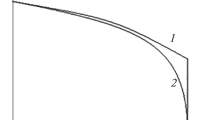Abstract
The interaction of oxygen with solid lead selenide samples prepared in the form of bulk single crystals, films, pressed pellets, and powders is investigated in the temperature range 298–823 K at exposure times of 5–240 min and an oxygen pressure of ∼105 Pa. All samples are produced from a lead selenide batch heat treated under dynamic vacuum. It is revealed that, under the given thermodynamic conditions, the PbSeO3 phase is formed on the surface of all the PbSe samples beginning with room temperature. No phase transformations are observed in the sample bulk. Lead selenite is synthesized using lead selenide precursor by the solid-phase method in an oxygen atmosphere at temperatures considerably lower than the melting temperature. At the intermediate synthesis stage, it is possible to prepare lead selenide nanocrystalline structures embedded in a PbSeO3 dielectric matrix.
Similar content being viewed by others
REFERENCES
Suzdalev, I.P. and Suzdalev, P.I., Nanoclusters and Nanocluster Systems: Organization, Interaction, and Properties, Usp. Khim., 2001, vol. 70, no.3, pp. 203–240.
Moshnikov, V.A. and Tomaev, V.V., Formation of Nanostructured Layers of Tin Dioxide-Indium Dioxide Solid Solutions with One-, Two-, and Three-Dimensional Nanomorphology, Izv. SPbGETU (LETI), St. Petersburg, 2003, no. 1, pp. 15–19.
Huynh, W.U., Dittmer, J.J., and Alivisatos, A.P., Hybrid Nanorod-Polymer Solar Cells, Science (Washington, D. C., 1883-), 2002, vol. 295, pp. 2425–2427.
Redl, F.X., Cho, K.S., Mirray, C.B., and O’Brien, S., Three-Dimensional Binary Superlattices of Magnetic Nanocrystals and Semiconductor Quantum Dots, Nature (London), 2003, vol. 423, pp. 968–971.
Bestaev, M.V., Makhin, A.V., Moshnikov, V.A., and Tomaev, V.V., A Technique of Preparing a Batch for Producing Lead and Tin Chalcogenide Solid Solutions by Vapor Phase Methods, RF Patent 2155830, 1997.
Izmailov, N.V., Il’in, Yu.L., Moshnikov, V.A., Tomaev, V. V., Yaroslavtsev, N.P., and Yas’kov, D.A., Determination of Lead Selenide Composition Corresponding to the Maximum Melting Temperature, Neorg. Mater., 1989, vol. 25, no.3, pp. 515–517.
Tomaev, V.V., Growth and Investigation of Lead and Tin Chalcogenide Single Crystals, Izv. SPbGETU (LETI), St. Petersburg, 2002, no. 1, pp. 34–41.
Rao, C.N.R. and Gopalkrishnan, J., New Directions in Solid State Chemistry: Structure, Synthesis, Properties, Reactivity, and Materials Design, Cambridge: Cambridge Univ. Press, 1986. Translated under the title Novye napravleniya v khimii tverdogo tela: Struktura, sintez, svoistva, reaktsionnaya sposobnost’ i dizain materialov, Novosibirsk: Sib. Otd. Akad. Nauk, 1990.
Trofimov, V.T., Selivanov, Yu.G., and Chizhevskii, E.G., Photoconductivity of Thin Epitaxial Lead Selenide Films, Fiz. Tech. Poluprovodn. (St. Petersburg), 1996, vol. 30, no.4, pp. 755–763.
Neustroev, L.N. and Osipov, V.V., Physical Processes in Photosensitive Polycrystalline Lead Chalcogenide Films, Mikroelektronika, 1986, vol. 17, no.5, pp. 399–416.
Popov, V.P., Tikhonov, P.A., and Tomaev, V.V., Investigation into the Mechanism of Oxidation on the Surface of Lead Selenide Semiconductor Structures, Fiz. Khim. Stekla, 2003, vol. 29, no.5, pp. 686–694 [Glass Phys. Chem. (Engl. transl.), 2003, vol. 29, no. 5, pp. 494–500].
Tomaev, V.V., Makarov, L.L., Tikhonov, P.A., and Solomennikov, A.A., Oxidation Kinetics of Lead Selenide, Fiz. Khim. Stekla, 2004, vol. 30, no.4, pp. 474–483 [Glass Phys. Chem. (Engl. transl.), 2004, vol. 30, no. 4, pp. 349–355].
Zlomanov, V.P., Popovkin, B.A., Tananaeva, O.I., and Novoselova, A.V., Investigation into Properties of Lead Selenite and Lead Oxyselenites, Zh. Neorg. Khim., 1962, vol. 7, no.12, pp. 2746–2751.
Zlomanov, V.P. and Novoselova, A.V., A Study of Interaction of Lead Selenide with Oxygen, Dokl. Akad. Nauk SSSR, 1962, vol. 143, no.1, pp. 115–118.
Popovkin, B.A., Kovba, L.M., Zlomanov, V.P., and Novoselova, A.V., A Study of Interaction of Lead Selenide with Oxygen, Dokl. Akad. Nauk SSSR, 1959, vol. 129, no.4, pp. 809–812.
Bube, R.H., Photoconductivity of Solids, New York: Wiley, 1960. Translated under the title Fotoprovodimost’ tverdykh tel, Moscow: Inostrannaya Literatura, 1962.
Zlomanov, V.P., Muratova, G.V., and Novoselova, A.V., Preparation of Lead Selenide, Zh. Neorg. Khim., 1960, vol. 6, pp. 1730–1731.
Abrikosov, N.Kh., Bankina, V.F., Poretskaya, L.V., Skudnova, E.V., and Shelimova, L.E., Poluprovodnikovye soedineniya, ikh poluchenie i svoistva (Semiconductors, Their Preparation, and Properties), Moscow: Nauka, 1967.
Ravich, Yu.I., Efimova, B.A., and Smirnov, I.A., Metody issledovaniya poluprovodnikov v primenenii k khal’kogenidam svintsa PbTe, PbSe, PbS (Methods for Investigating Semiconductors as Applied to PbTe, PbSe, and PbS Lead Chalcogenides), Stil’bans, L.S., Ed., Moscow: Nauka, 1968.
X-ray Diffraction Date Cards, ICDD, 2002, nos. 15-462-15-471.
Fischer, R., Die Kristallstruktur von Molybdomenit, PbSeO3, Tschermaks Mineral. Petrogr. Mitt., 1972, vol. 17, pp. 196–207.
Kovtunenko, P.V., Fizicheskaya khimiya tverdogo tela. Kristally s defektami (Physical Chemistry of Solids: Crystals with Defects), Moscow: Vysshaya Shkola, 1993.
Morrison, S.R., The Chemical Physics of Surfaces, New York: Plenum, 1977. Translated under the title Khimicheskaya fizika poverkhnosti tverdogo tela, Moscow: Mir, 1980.
Barinskii, R.L. and Nefedov, V.D., Rentgenospektral’noe opredelenie zaryadov atomov v molekulakh (X-ray Spectral Determination of Atomic Charges in Molecules), Moscow: Nauka, 1966.
Abrikosov, N.Kh. and Shelimova, L.E., Poluprovodnikovye materialy na osnove soedinenii A4B6 (Semiconductor Materials Based on AIVBVI Compounds), Moscow: Nauka, 1975.
Aleskovskii, V.B., Khimiya nadmolekulyarnykh soedinenii (Chemistry of Supramolecular Compounds), St. Petersburg: St. Petersburg Gos. Univ., 1996.
Polyakov, A.A., Tekhnologiya keramicheskikh radioelektronnykh materialov (Technology of Ceramic Electronic Materials), Moscow: Radio i Svyaz’, 1989.
Popovkin, B.A., Zlomanov, V.P., and Novoselova, A.V., A Study of Thermal Decomposition of Lead Selenate and Lead Selenite, Zh. Neorg. Khim., 1960, vol. 5, no.10, pp. 2261–2264.
Author information
Authors and Affiliations
Additional information
Original Russian Text Copyright © 2005 by Fizika i Khimiya Stekla, Tomaev, Makarov, Tikhonov, Popov, Rozhdestvenskaya.
Rights and permissions
About this article
Cite this article
Tomaev, V.V., Makarov, L.L., Tikhonov, P.A. et al. Formation of Lead Selenide Crystallites in a Dielectric Matrix of Lead Selenite. Glass Phys Chem 31, 489–498 (2005). https://doi.org/10.1007/s10720-005-0088-7
Issue Date:
DOI: https://doi.org/10.1007/s10720-005-0088-7




